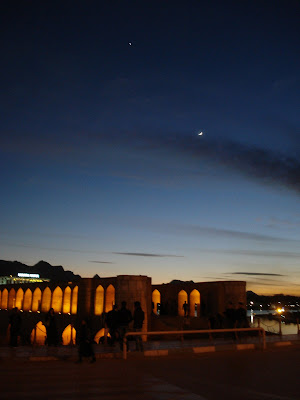Shahsevan
I have visited northwestern Iran in 2005, just after the election of current Iranian president Mahmoud Ahmadinejad. I stayed only 72 hours or so and went on to Mashhad but, as usual when in Iran, I have met a couple of nice people there, in particular Dawoud and Alireza, who didn’t mind to show me around. So, I had the opportunity of having a ride to Daryacheh Orumiyeh and another to Kandovan. I have reported on these trips here and here on this blog.
That memories lasted long was partly due to the purchase of a very nice small Shirvan rug for my own tiny gallery. Its owner Dawoud, a very knowledgeable carpet collector and honorable dealer in Tabriz, was rather reluctant to sell it to me since he had it in his own flat for 20 years. I knew at that time already that Shirvan was a region in Azerbaijan in Transcaucasia. Buying that small rug didn’t make me a collector, though. The people, exotic places, adventures, and the circumstances of finding collectibles in original places, the bargaining made it, which fascinated me. I have told the stories about Seyed and Mirwuis, Ali and Hussain, Mr. Okhravi and his eldest son Sirus here on this blog. Of course I was fully aware of spending most of the time money on rubbish. But I didn’t mind.
Well, that might have been changed since I am living in a much more boring region right now, far away from exotic places and with no time anymore for extensive travelling in particular in the Middle East. When planning this year’s holidays in Istanbul, I eventually dared to contact a German carpet dealer whom I had located in Munich before (but who currently has his business in Istanbul) and whose webpage with special antique rugs and textiles from the Middle East and Central Asia I had frequented for some time. I asked for a particular Shahsevan bag (khorjin) face displaying tastefully, indeed elegantly, arranged Memling guls and which was allegedly from 1800. It looked so new! Brilliant colors, no visible damage. The carpet dealer, Bertram, enlightened me that it had been restored, of course. By courtesy he provided me with a picture of the piece indicating how it looked when he had bought it. I admit that, given the price he mentioned, I lost somewhat interest in the piece. Should I pay the huge amount for the masterful repair or the antique? It seems so as if, well, sort of over-restoration had created a completely different piece of art here.
The following weeks, Bertram and I had a spirited exchange of emails. I could learn a lot from him, he told the novice. And he was right! We exchanged our differing experiences which we had made in the Middle East. He had travelled in the 1970s, as so many young people from the West, to Iran, Afghanistan, India. Morgenlandfahrer, as Hermann Hesse would have called them. After the Islamic revolution, though, he had avoided entering in Iran. Amazing that, when I recently asked Abbas Okhravi in Mashhad, he remembered a young German guy called Bertram whom he had actually met then.
I was interested in one of his pieces which resembled, in design, my Shirvan rug. He told me that it was not extraordinary but interesting anyway and had belonged to the collection of bag faces collected by a German engineer, Hans-Gerhard Bach, who had died in 2000. He had been commissioned to sell these pieces; some were of very high quality, most had been sold already. He had published the best pieces in a book and kindly provided me with a copy and another copy of his other gorgeous book about Shahsevan sumakh bags.
Due to some circumstances, I missed Bertram in Istanbul. He suggested visiting Seref Özen and Mehmet Çetinkaya in Istanbul, famous and knowledgeable carpet dealers with most interesting stuff.
The latter’s gallery, a temple of exquisite taste and a gold mine for both its owner and the opulent (I am not) connoisseur, impressed us very much. Mehmet’s catalogue with an explicit statement and beautiful examples of the very fact that tribal art of Central Asia might have antedated 20th century’s Modernism by several hundred years is stunning. The two pieces from Transcaucasia (Shahsevan, Moghan), which I bought there, were expensive but not so special.
The bag face below is from the Bach collection (plate 32). Initially classified as Shahsevan, Bertram now considers it Luri. It has a special patina and might be one of the oldest, from the early 19th century. The other piece is a Shahsevan from Qeydar, a small town south of Zanjan in the Khamseh district in Azerbaijan. It may be the other face of a mafrash displayed here; same but not identical.
More about the Shahsevan, a confederacy of nomadic tribes “loyal to the shah” at the frontiers of Azerbaijan, can be found in Richard Tapper’s book. More about their mainly flat weavings can be found here.
















Comments